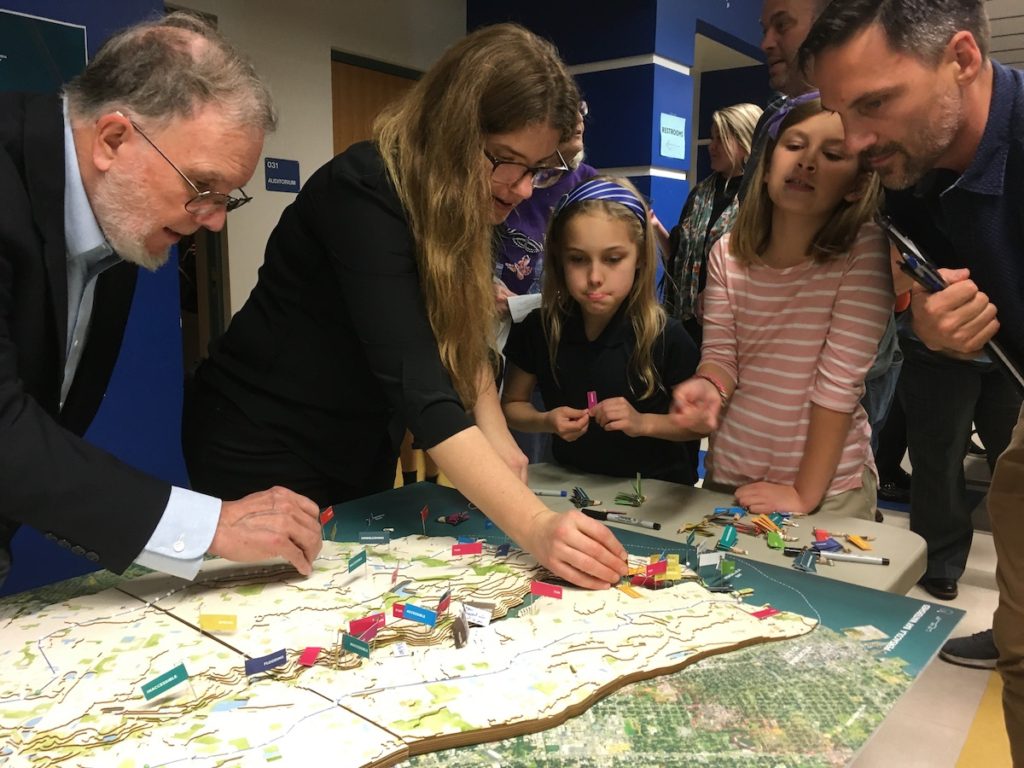By Jeremy Morrison, Inweekly
Looking over the three-dimensional model with tiny flags planted on it, the little girl had a question.
“What is this?†she asked.
“This is the watershed,†explained Gena Wirth, a landscape architect with the New York-based SCAPE firm. “Every drop of water that goes in here flows into the bayou.â€
It’s a simple enough concept — water flowing into a creek, then onward — for a child to understand. But ensuring that a watershed is healthy, or restoring a watershed after its health has declined, is a much more complicated proposition.
Carpenters Creek in Pensacola, flowing through town and into Bayou Texar, then Pensacola Bay, represents such a challenge. Once deep and wide and a source of recreation and fishing, the creek has suffered from years of development in its watershed, becoming plagued with trash and filled in via erosion due to residential build-up and massive parking lots draining into it. Once an active vein in the local community, Carpenters Creek has become lost and soiled over the years.
“You don’t even know when you’re driving over,†Wirth said, explaining how the creek trickles by unnoticed beneath overpasses. “You might be right next to Carpenters Creek and have no idea.â€
Wednesday evening, local officials hosted a community meeting focused on creating a Carpenters Creek and Bayou Texar Watershed Management Plan. The plan will evaluate the health of the watershed and map out how best to improve that health. This project is a restoration effort funded through RESTORE money, or dollars stemming from environmental penalties associated with the 2010 BP oil spill in the Gulf of Mexico.
Noting the approaching 10-year anniversary of the Deepwater Horizon spill, Escambia County Commissioner Robert Bender made a connection between that environmental disaster and the current local watershed restoration project: “It’s a reminder of both why we’re doing it and what we want to prevent from happening in the future.â€
This week’s watershed management plan meeting was the first in a series of meetings and the beginning of a lengthy journey that will go on for years. Escambia County, which is overseeing this project, expects to realize a watershed management report by 2023. In between now and then, the watershed’s state will be assessed and plans to improve its health will be established.
“You’re probably thinking, ‘whoa, this is a long time,†Wirth told attendees Wednesday night, explaining the complexity of the project. “It’s a huge area, and there’s a lot of unknowns.â€
In addition to the team from SCAPE — which recently worked on planning projects in the downtown core — this watershed restoration project is being handled by Wood Environment and Infrastructure firm. Key goals of the project are improving water quality, managing water quantity, restoring fish and wildlife habitat, enhancing public access and recreational opportunities and better connecting residents to the watershed.
During this initial meeting on the watershed management plan, a presentation of the history and current state of the watershed, creek and bayou were offered. Attendees were asked for their own stories concerning the creek and bayou so that planners may better set their compass before embarking on the project.
“Our primary goal is to have a conversation,†explained Lee Altman, a planner with SCAPE. “Listen to your stories, your history, your knowledge.â€
“Are we hitting the right points?†asked Wirth.
Pensacola City Councilwoman Sherri Myers, who has long championed restoration efforts for Carpenters Creek, said she was glad to see the watershed management plan process beginning, but that the creek needed the immediate and continued attention of volunteers to clear debris from the watershed.
“We’re going to continue doing what we’ve always done,†Myers said, following Wednesday’s presentation. “There’s continuous issues that can’t wait for a plan.â€
Of course, even with ongoing cleanups conducted by committed community volunteers, or even with deep-dive watershed management plan projects, some issues are impacting the watershed that pose formidable obstacles: like the proliferation of big box stores and their expanses of impermeable parking lots, or as was the case this past week, the Emerald Coast Utilities Authority reported a spill of more than 300,000 gallons of raw sewage near Boiling Brooke Circle, in proximity to the headwaters of Carpenters Creek.
— For more information on the current watershed planning process, visit restorethewatershed.com
